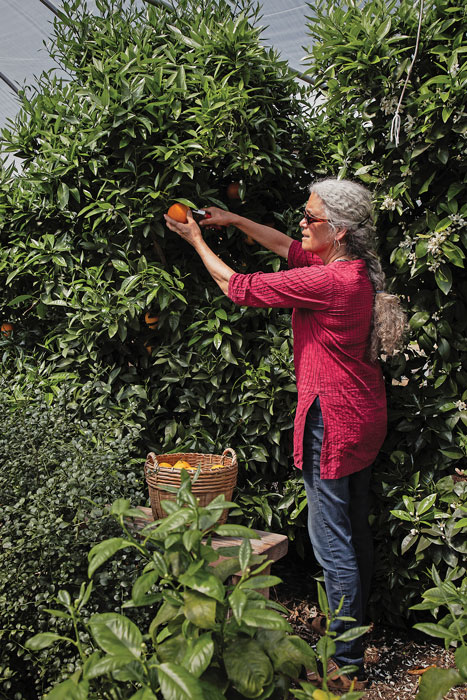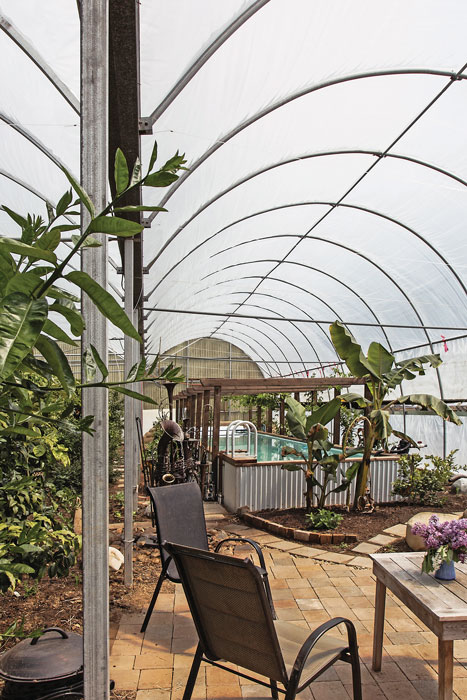6/1/2020
The Path Less Travelled
Anne-Marie Hardie

Salt Spring, British Columbia, is known for its temperate climate: rainfall, beautiful landscapes and its sunny weather. This hidden Canadian gem is ideally suited for a range of plant life, including a few varieties of palms and even bananas.
Amid this beauty resides a 3-acre farm, The Garden, which is owned and operated by Jane Squier—a grower who isn’t intimidated to traverse onto the path less traveled. It’s a fully sustainable, small-scale, 6,000-sq. ft. operation that incorporates rainwater harvesting, hydronic heating, energy curtains and solar panels for backup energy. Today, The Garden is home to over 40 exotic citrus plants and avocados that are grown exclusively with renewable energy and thermal mass.
Pictured: Jane Squier, owner of The Garden in British Columbia, picking the last of the winter fruit surrounded by the intoxicating fragrance of orange blossoms.
Jane’s curiosity for growing was ignited by her mother, Kit Lewis, who gifted each of her children a simple package of seeds and a lesson in home gardening.
“I remember that my package was carrots,” she said. “That type of miracle, of watching seeds grow, has never left me.”
An adventurer at heart, Jane lived off the grid in the ’70s and then traveled to Papua New Guinea, where she worked as a district horticulturist. It was here that she nurtured her love for growing and an awareness that she would like to continue growing back home. However, with a struggling Canadian economy, Jane knew that starting a new business presented a challenge.
It was an article about a small hydroponic Ontario grower in Harrowsmith magazine that would present an idea that would help shape Jane’s and her husband, Jamie’s, future.
“I remember thinking that this new way of growing could be the key to coming home,” said Jane. The couple explored the potential of hydroponics and set the wheels in motion to launch a wholesale hydroponic lettuce operation in Alberta.
It was 1982; hydroponics was in its infancy in Canada with only a few growers across the country. Their idea received support from both extension officers and the government, who offered help with lab work and water analysis.
“We didn’t need to do a big marketing push; the product sold itself,” said Jane. “It was hard to get fresh produce in Calgary at that time and customers were immediately drawn to the bright green lettuce.”
The business quickly expanded, tripling in size in only a few years. It was coming to a point, shared Jane, where family and work life were beginning to become in conflict.
“I wanted my children to grow up in a small community and to live within walking distance of their schools. We decided to move to an island off the coast of British Columbia to seek a slower-paced lifestyle,” she said. The Calgary hydroponic farm was sold as a turn-key operation and they opened a smaller business in British Columbia.
Their 10 years of experience with hydroponics enabled them to design a small, yet highly efficient, system for growing living lettuce. By scaling down, she was able to become more involved with both her family and her new community.
 It was the separation from Jamie that marked the turning point in Jane’s career.
It was the separation from Jamie that marked the turning point in Jane’s career.
“The work shifted from part-time to more than full-time and I still had kids at home,” said Jane. “I kept looking for ways to cut my work hours and lower the stress level.”
The first steps included building a walk-in cooler, increasing water storage and automating as much as possible.
“Shipping off-island weekly was taking too much time, so I diversified, got into basil and different types of lettuce and was able to sell everything on the island,” she said.
Pictured: The 40 ft. x 7 ft. x 6 ft. tank serves three purposes: rainwater catchment, thermal mass for storing heat in the winter and a lovely lap pool. By summer, the passion fruit vines cover the trellis.
As the children left home and the growing became more specialized, Jane realized she had 3,000 sq. ft. that could be used for experimenting with alternate crops. She was enticed by the challenge of growing subtropical fruit in Canada with low-energy inputs. The first planting, in 2014, consisted of 20 varieties of citrus and 10 avocado trees imported from a nursery in Oregon. The plants were shrouded with Reemay cloth and captured the heat from Christmas lights on a thermostat to keep the citrus from freezing over the winter.
“It was not the best system for me because I couldn’t see the fruit as they ripened from late October to April,” said Jane. “I knew I needed a more sophisticated heating system.”
Her goal was to develop a system that would encourage the healthy growth of the citrus plants with minimal inputs. She launched into the research process, scouring the internet and her circle of friends for sustainable solutions.
The solution involved a hydronic system that used a high-efficiency wood gasifier. Two insulated rainwater tanks (15,000 gal.) in the greenhouse were incorporated to store heat and increase the overall efficiency of the wood furnace.
“I try to keep the greenhouse above 4 degrees Celsius. If the forecast is minus 8 Celsius, I heat the water in the tanks ahead of time,” said Jane. “I also use energy curtains that reduce heat loss by up to 40%.”
Since groundwater is in short supply, the business runs exclusively on rainwater collected and stored on the property, a total of 70,000 gal. The on-farm nutrient cycle is maintained through composting and the use of a small prototype anaerobic digester, which transforms kitchen waste into nutrient-dense fertilizer and methane gas for cooking. Always looking for more efficient solutions, Jane is in the process of installing solar evacuated tubes to heat the water tanks and to decrease her reliance on the wood gasifier further.
In addition to her citrus garden, Jane offers workshops educating others on the methods that she’s integrated into The Garden, including energy-efficient greenhouse design considerations, anaerobic digestion and integrated pest management.
Six years after the first citrus tree was planted, the greenhouse is now fully transitioned to subtropical fruit production.
“Citrus, avocados, passion fruit, jujubes, bananas, pomegranates and other fruit ripen throughout the year,” she shared. “It’s amazing to see what will survive the winter’s low temperatures and low light levels.” GT
Anne-Marie Hardie is a freelance writer/speaker from Barrie, Ontario, and part of the third generation of the family-owned garden center/
wholesale business Bradford Greenhouses in Barrie/Bradford, Ontario